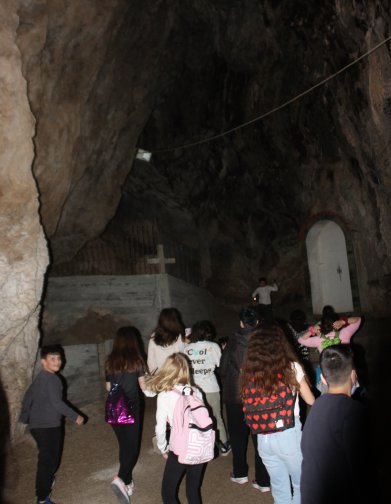Kefalari . . .
This ancient place of worship, with its picturesque temple of Zoodochos Pigi, is still a reverent pilgrimage site for the locals, but also a cool resort around the springs of Erasinos, a total of 7 kilometres from Argos, to whose municipality it belongs.
 |
 |
From the cavernous depths and the underground streams of the great mountain ranges of Arcadia come the Erasinos. It is a capricious river, but also a sacred protector of the land and its inhabitants, sometimes with its floods and sometimes with its drought. The mills of Argos were once powered by its waters. The first paper mill was founded next to it in 1829 and a public silica factory in 1833. A first gunpowder explosion destroyed it in 1868, followed by a second dramatic explosion in 1908 with many casualties and damage.
The small lake formed by the water immediately after the springs and below the church of Zoodochos Pigi is beautiful. All around are large plane trees, in the shade of which are the huts. The landscape culminates in the conical stone mound of the Prophet Elias and the white and white chapel on its summit, Mount Haon of antiquity. Kefalari is also known for its cave, which used to be an underground riverbed. The ancient Greeks believed that the waters of Lake Stymphalia originated here and celebrated a lively festival every year in honour of Pan and Dionysus, the "Tyrvi". On the walls of the cave - the accessible part is not large, but limited to a depth of about 30 metres - there are some niches that probably contained votive figures. Neolithic pottery was found during a rough excavation at the beginning of the century, but the cave had been inhabited by people much earlier.
German archaeologists who carried out excavations in the middle of the room (R. Felsch 1972 and L. Reisch 1975-76) found blades and arrowheads from the beginning of the Upper Palaeolithic, i.e. from around 35000 BC! Despite these significant finds, no further excavations have been carried out since then, and so the cave continues to guard its secrets.
However, the caves have always been attractive as places of worship, and so in later years the Virgin Mary of Kefalariotissa came here. The church of Zoodochos Pigi, the Virgin Mary of Kefalariotissa, was built by Leo I, according to tradition. Emperor Justinian and other emperors added to it. It was rebuilt in 1833 - its dedication in 1835 was also commemorated by the Patriarch - and its dedication is celebrated on the Friday after Easter, the Friday after the Feast of the Diaconia. It still attracts crowds of pilgrims today.
It is worth noting that two kilometres from Kefalari are the remains of the only pyramid in Greece:
 |